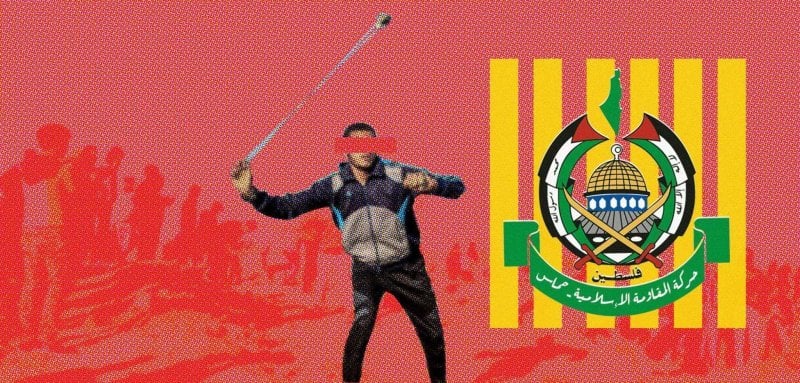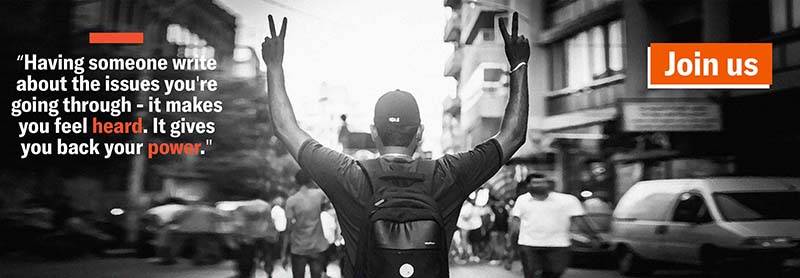A group of young Gazans went out to the streets of the besieged enclave on March 14, raising the slogan “We want to live” (Badna Na’ish) to commemorate the twelfth anniversary of the Israeli blockade of the densely-populated territory.
Twelve years of abjectness, exploitation and sanctions by the occupation have led to the destruction of their futures – not to mention the punitive measures imposed by the Palestinian Authority from the West Bank on its employees in the Strip, or the imposition by Hamas of exorbitant taxes on basic living commodities.
However, instead of allowing Gaza’s youth to exercise their rights to protest as protected under Palestinian law, Hamas’s security forces have responded to the protests by suppressing anyone who dared to go to the streets – beating and arresting protesters – while also arresting some journalists and seizing their equipment, preventing reporters from covering the event.
Later that same night, two rockets were fired from Gaza into Israel, falling near Tel Aviv – prompting the Israeli government of Benjamin Netenyahu to respond with force.
Hamas subsequently denied responsibility for the rocket-fire – which was instead claimed by the newly-founded “Arab Resistance Movement to Liberate Palestine” in its first public statement. Israel cared little about the distinction however and proceeded to bomb several targets across the strip in the middle of the night – terrorising and unsettling civilians in the process, and placing Gaza’s women, children and elderly under further psychological duress. Fearful of a fourth major war in little more than a decade, such an event would add further misery onto their already-arduous living conditions.
The round of Israeli bombardment ended without eliciting a response from the resistance factions. In the aftermath of the airstrikes, it appeared that Hamas believed its citizens would now become too preoccupied with the latest enemy bombardment, meaning that the nascent youth movement had come to a quick end.
However, calls inviting residents to continue protesting in Gaza’s streets and squares resumed the next morning – demanding the continuation of the popular movement and rejecting the state of hunger, siege, punitive measures and taxes imposed on Gaza’s mostly-young population. It should be noted that according to estimates by statistical centres, more than 50% of Gaza’s youth are unemployed.
Hamas was now in need of an opportunity by which it could mobilise its crowds to counteract the emerging opposition. The opportunity would unexpectedly arrive on a silver platter from the West Bank, where a Palestinian youth stabbed an Israeli soldier and seized his weapon – proceeding to shoot two more. Hamas capitalised on the event to call for large popular rallies in support of the resistance in Gaza – with the rallies to take place in the same locations and times of the opposition protests.
Hamas’s mobilisation was subsequently criticised in several quarters for its potential to disturb the civil peace, causing the youth movement to postpone their rally for two hours to avoid friction and clashes between the two sides.
The ever-ready fait accompli government, Hamas quickly proceeded to contradict itself by offering full media freedom (indeed, actively supporting it) in the coverage of its own protests, while simultaneously instituting a complete blockade on coverage of the youth movement’s protests – particularly in the city of Deir al-Balah in central Gaza, which witnessed deplorable acts of suppression, arrests and even house-raids, seemingly without any regard for the sanctity of Gazan homes.
Nonetheless, videos would later circulate on social media in the aftermath of the event – exposing the actions of the Hamas security apparatuses as well as the participation of members of the Izz ad-Din al-Qassam Brigades (Hamas’s military wing) in the early days of the crackdown, according to eyewitness reports and victim testimonies.
Because of the crackdown, the youth movement has since vacated Gaza’s squares and moved its activities to the pages of Facebook. However, even this step has taken place under the watchful eye of the security apparatus, with dozens being summoned for investigation in security headquarters for their online postings on the protests.
In other words, at the moment that Hamas was supposed to embrace its citizens – and in fact harness the movement’s potential to advocate for its demands – it chose instead to exercise the same mentality it previously exhibited during previous protest movements, when it similarly arrested activists and public figures calling for general freedoms and basic human rights.
On the other hand, the protests did receive coverage in the official media platforms of the Palestinian Authority (Fatah) and some of its public figures – however, this would provide Hamas security forces with a strong pretext for carrying out further transgressions against Gaza’s youth, accusing them of collaborating with Ramallah.
This charge was levelled directly at some of the leaders of the “We want to live” movement – who are still detained to this day by Hamas, and have been referred to military courts (despite being civilians) on the charge of collaborating with hostile foreign entities, in violation of domestic law. During the crackdown, Gaza’s security forces arrested more than 1,000 citizens over six consecutive days – while the Health Ministry has refused to reveal the number of injured and wounded in the protests, which the Independent Commission for Human Rights (ICHR) estimates to number in the hundreds. Such events could create a fertile environment for the incitement and carrying out of future acts of violence, with dangerous potential repercussions.
Yet the protest movement facing Hamas is not the most dangerous challenge confronting Gaza on the Palestinian arena; rather, a greater danger was the spread of leaks surrounding a possible agreement between Hamas and Israel reached via Egyptian mediation – which was evident in the aggressive Israeli response on Gaza following the launching of the two rockets.
Suddenly however, the relationship between Israel and Hamas returned to normal after a third instalment of Qatari funds entered Gaza two days later. Media reports circulated that Hamas had rejected the Israeli terms for a ceasefire, and the weekly-held maritime demonstrations against the blockade in the northern Gaza Strip were resumed. This was accompanied with the usual nightly Israeli disruption operations, which led to the killing of one Palestinian demonstrator.
This ebb and flow between Hamas and Israel continued until the morning of March 25, when two long-range rockets were fired from the southernmost point of the strip, landing on an Israeli house in the Sharon plain near Tulkarm (i.e. further north than Tel Aviv). This was followed on the one hand by aggressive statements from Israeli ministers and army commanders urging a forceful response to the rocket-fire – and on the other by Hamas disowning responsibility for the rockets, and Gaza’s resistance factions warning of a response to any Israeli bombardment of Gaza.
As expected, the Israeli army would nonetheless launch several airstrikes on various targets, security installations and houses across the Strip – met in turn by the launching of some rockets from the Strip. Israeli military experts estimate that the escalation continued for more than one day. It should be mentioned that this bout of violence took place only five days before the first anniversary of the ‘March of Return’, in which Hamas was a major mobiliser alongside several other Palestinian factions.
Ultimately, all of this takes place while the Gazan citizen pays the price for this exchange and barter between Hamas and Israel, which comes at the expense of the future of Gaza’s residents and their enjoyment of the most basic of rights for dignified and safe living. Meanwhile, Hamas aspires to accomplish a political achievement which can solidify its rule – with the movement considering the recent internal turbulence and deterioration inside Gaza as a threat which, if left unchecked, could cost it heavily in the future.
By contrast, the Israeli escalation does not produce the same level of anxiety for Gaza’s rulers, who do not view their domestic or international image as being tarnished by such an event; on the contrary, the Israeli escalation has been framed as an achieved “victory”, further reinforcing Hamas’s image as a resistance movement domestically and worldwide.
Raseef22 is a not for profit entity. Our focus is on quality journalism. Every contribution to the NasRaseef membership goes directly towards journalism production. We stand independent, not accepting corporate sponsorships, sponsored content or political funding.
Support our mission to keep Raseef22 available to all readers by clicking here!






Join the Conversation
Tester WhiteBeard -
10 hours agoEgypt
Tester WhiteBeard -
10 hours agoGreat
Ayar Abdelkreem -
1 day agoكانت مكتوبة مقال رأي وتم رفضه من رئيسة التحرير،
Ayar Abdelkreem -
1 day agoكانت فكرتي
Samah Al Jundi-Pfaff -
1 day agoأرسل لك بعضا من الألفة من مدينة ألمانية صغيرة... تابعي الكتابة ونشر الألفة
Samah Al Jundi-Pfaff -
1 day agoاللاذقية وأسرارها وقصصها .... هل من مزيد؟ بالانتظار